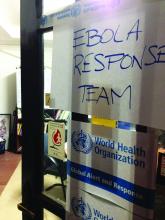The struggle to defeat Ebola virus disease continues globally, although it may not always make the headlines. To catch up on what you may have missed, here are some notable news items and journal articles published over the past few weeks that are worth a second look.
The National Institutes of Health has established a new program to strengthen the research capacity to study Ebola, Lassa fever, yellow fever, and other emerging viral diseases.
The Ebola virus matrix protein VP40 is released from transfected and infected cells in a soluble form through an unconventional secretion pathway, according to a recent study.A special supplement on the Ebola outbreak in West Africa was released by The Journal of Infectious Diseases.
Investigators at Virginia Tech University, Blacksburg, released a study on the aerosolization of Ebola virus, which includes emission rates that could help inform risk assessment of inhalation exposure to Ebola virus.
Insights from a recent study into the molecular interactions behind the Ebola virus suggest new approaches for fighting the disease, specifically, blocking the viral protein from binding to Niemann-Pick C1 protein.
Despite challenges, the hazardous work with Ebola virus disease (EVD) patients in Sierra Leone was experienced as meaningful by health care workers and an important motivator, according to a study in the Journal of Advanced Nursing.
Researchers combined two common modeling methods – estimation of epidemic parameters using mathematical models, and estimation of associations using ecological regression models – to identify some factors predicting rapid and severe EVD epidemics in West African subnational regions.
A report in Nature showed how evolutionary analyses of Ebola virus genome sequences provided key insights into virus origins, evolution, and spread during the 2013-2016 West African epidemic.
Chinese researchers said there is no robust evidence that the 2014 Ebola virus outbreak in West Africa was fast-evolving and -adapting to humans, and that the unprecedented nature of the 2014 outbreak might be more likely related to nonvirological elements, such as environmental and sociological factors.
Several concerns were associated with new Ebola vaccine candidates, according to a recent analysis, including the safety profile in some particular populations, the immunization schedule for emergency vaccination, and the persistence of the protection.
Age younger than 5 years, bleeding, and high viral loads were poor prognostic indicators of children with EVD, according to results of a study in Liberia and Sierra Leone.
Fear, myth, and misconceptions were common among health care workers during the 2014 EVD outbreak in Nigeria, according to a study in PLOS One. The authors said strategies to allay fear are required to contain future outbreaks of EVD in Nigerian hospitals.
The risk of nosocomial transmission of the Ebola virus within Ebola Holding Units during the 2014 EVD epidemic in Sierra Leone was low, according to a recent analysis.
An unusual case of Ebola virus chain of transmission was uncovered in Conakry, Guinea in 2015, according to a research letter in Emerging Infectious Diseases.
On Twitter @richpizzi


